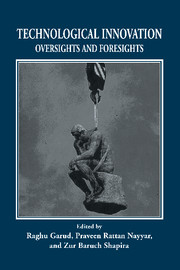Book contents
- Frontmatter
- Contents
- Contributors
- Foreword
- Preface
- Section I Introduction
- Section II Learning to flip coins
- 2 On flipping coins and making technology choices: Luck as an explanation of technological foresight and oversight
- 3 Technological choices and the inevitability of errors
- 4 Rational entrepreneurs or optimistic martyrs? Some considerations on technological regimes, corporate entries, and the evolutionary role of decision biases
- Section III Tailoring fits
- Section IV Remembering to forget
- Section V (S)Top management and culture
- Section VI Clearing the fog
- Author Index
- Subject Index
4 - Rational entrepreneurs or optimistic martyrs? Some considerations on technological regimes, corporate entries, and the evolutionary role of decision biases
Published online by Cambridge University Press: 07 October 2011
- Frontmatter
- Contents
- Contributors
- Foreword
- Preface
- Section I Introduction
- Section II Learning to flip coins
- 2 On flipping coins and making technology choices: Luck as an explanation of technological foresight and oversight
- 3 Technological choices and the inevitability of errors
- 4 Rational entrepreneurs or optimistic martyrs? Some considerations on technological regimes, corporate entries, and the evolutionary role of decision biases
- Section III Tailoring fits
- Section IV Remembering to forget
- Section V (S)Top management and culture
- Section VI Clearing the fog
- Author Index
- Subject Index
Summary
Introduction
This is a rather conjectural report on the evolutionary role of decision biases— at both the level of individuals and of organizations—and, in particular, on their importance to the processes of corporate entry and the evolution of industrial structures. A growing and quite robust body of evidence highlights the pervasiveness of various types of biases in individual decision making, which accounts for systematic departures from predictions of the canonical model of rational choice (see, for example, Kahneman & Tversky, 1973, 1986, Shafir & Tversky, 1992). For our purposes, we will mainly concern ourselves with overconfidence or optimism, which frequently leads to bold forecasts of the consequences of one's own actions. Also, by way of example, we will examine risk seeking in the domain of losses, which often yields escalating commitments in the face of failures. Interestingly, these biases appear to carry over from the level of individuals to that of groups and organizations and, indeed, might even be amplified in the latter circumstances (see, for example, Kahneman & Lovallo, 1993, Lovallo, 1996a, and the literature discussed there). In this respect, a challenging domain of investigation – with vast ramifications into the analyses of the nature of entrepreneurship, technological change, and industrial dynamics – is that of corporate entry into an industry.
- Type
- Chapter
- Information
- Technological InnovationOversights and Foresights, pp. 41 - 68Publisher: Cambridge University PressPrint publication year: 1997
- 36
- Cited by

